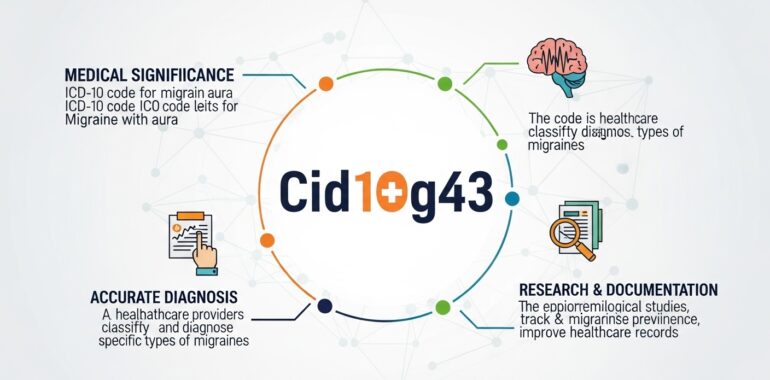Cid10g43: A Comprehensive Guide to Migraine Classification and Diagnosis

Cid10g43: A Comprehensive Guide to Migraine Classification and Diagnosis
When it comes to medical terminology and disease categorization, Cid10g43 holds an important place. This specific code is part of the ICD-10 classification system used globally to identify and record different health conditions. In medical records, Cid10g43 is primarily associated with migraines — a complex neurological disorder that affects millions of people worldwide. Understanding Cid10g43 can help patients, doctors, and health organizations manage and interpret migraine-related data more effectively.
What Is Cid10g43 and Why It’s Used
The code Cid10g43 stands for migraine within the International Classification of Diseases (ICD-10) developed by the World Health Organization. It provides a standardized way to record migraine diagnoses, making medical communication more precise and consistent across different hospitals and countries. With Cid10g43, doctors can easily document migraine cases in patient files, ensuring that anyone reviewing the record instantly understands the condition without confusion.
The Medical Importance of Cid10g43
Migraines can vary greatly from one person to another, involving symptoms like throbbing pain, nausea, and sensitivity to light or sound. The use of Cid10g43 ensures these conditions are identified and categorized properly. This helps healthcare professionals track the severity, frequency, and type of migraine a patient experiences. When coded under Cid10g43, such information can be used to guide treatment decisions, monitor progress, and evaluate the effectiveness of medications or therapies.
Cid10g43 and Data Accuracy in Healthcare
Accurate medical data is crucial for healthcare systems to function efficiently. Cid10g43 supports this by offering a uniform identifier for migraine cases. When clinics and hospitals use Cid10g43, they contribute to national and global databases that track disease patterns. This data is later analyzed by researchers to understand trends, identify triggers, and improve treatment methods. Without codes like Cid10g43, healthcare data would be inconsistent and difficult to analyze.
How Cid10g43 Helps in Insurance and Billing
Beyond diagnosis, Cid10g43 plays a practical role in the administrative side of healthcare. Insurance companies rely on standardized codes to process claims correctly. If a patient is diagnosed with a migraine and the doctor records it using Cid10g43, the insurance provider immediately recognizes the condition and processes the claim accordingly. This prevents delays, misunderstandings, or rejection of valid claims due to unclear medical records.
Research and Public Health Insights Through Cid10g43
Public health agencies use data categorized under Cid10g43 to understand how migraines impact communities. Researchers study how often migraines occur, which populations are most affected, and how environmental or lifestyle factors influence the condition. The widespread use of Cid10g43 enables accurate comparison between regions and countries. This shared knowledge helps in developing better healthcare policies and awareness programs aimed at migraine prevention and management.
The Role of Medical Professionals in Using Cid10g43 Correctly
Using Cid10g43 accurately is a professional duty for healthcare workers. Incorrect coding could lead to data errors, wrong treatment plans, or flawed research outcomes. Therefore, doctors, nurses, and medical coders must stay updated with the latest ICD-10 revisions related to Cid10g43. Their diligence ensures that each migraine case is correctly documented and contributes positively to global health data accuracy.
Cid10g43 in Everyday Medical Practice
In everyday practice, Cid10g43 simplifies how doctors record patient conditions. Instead of lengthy descriptions, they can enter Cid10g43 in electronic health records, saving time while maintaining clarity. This coding also helps multidisciplinary teams — such as neurologists, therapists, and pharmacists — to coordinate patient care efficiently. In short, Cid10g43 helps bridge communication gaps between healthcare departments and ensures all professionals are aligned in their understanding of the patient’s condition.
Conclusion
Cid10g43 is not just a code—it’s an essential tool for accurate diagnosis, data management, and healthcare improvement. It unifies how migraines are understood, documented, and treated globally. By ensuring precision in medical reporting, Cid10g43 supports better research, smoother insurance claims, and improved patient care. For anyone dealing with migraines, understanding Cid10g43 means understanding how modern medicine classifies and combats this widespread neurological issue.